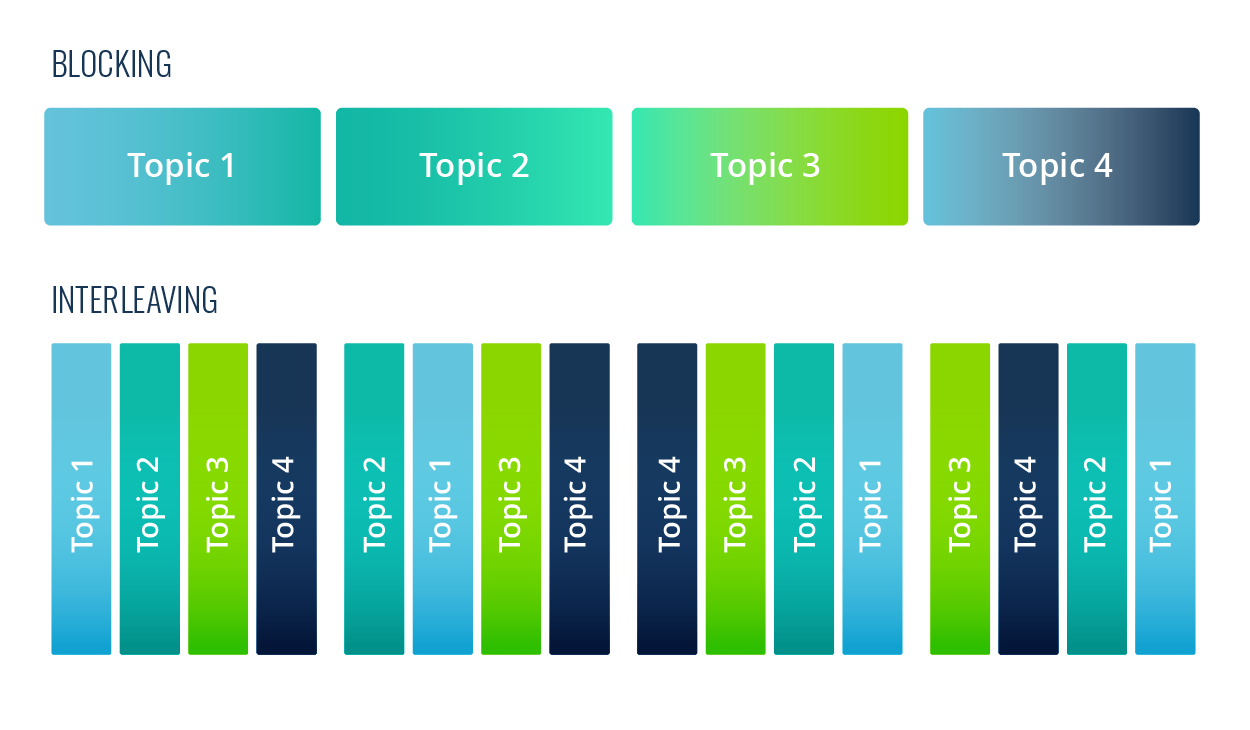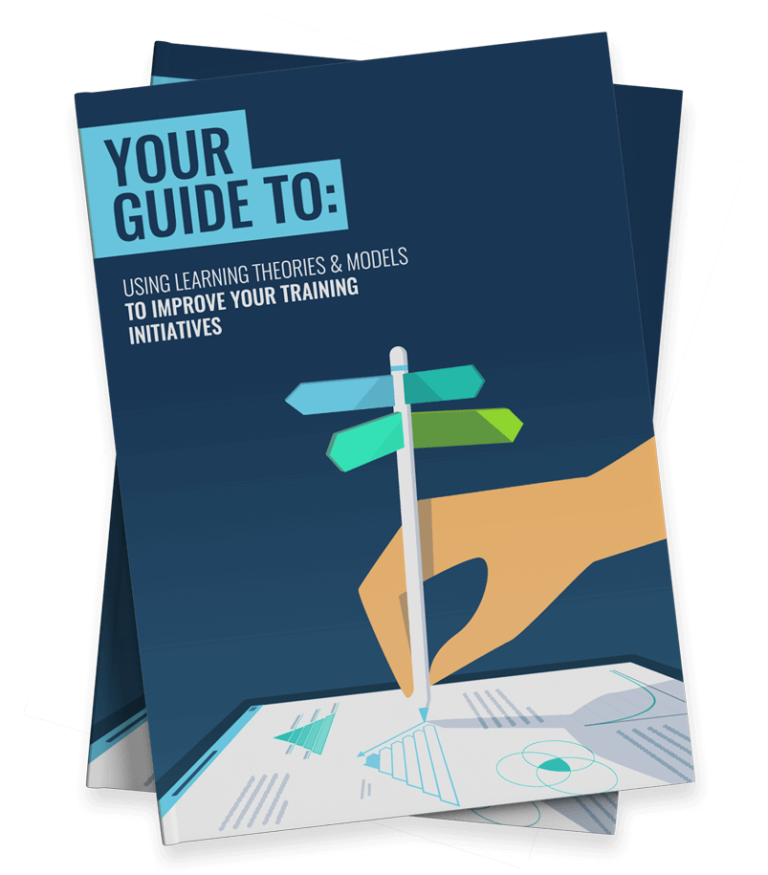
Interleaving is a powerful learning technique that can significantly improve understanding and retention. This could be a game-changer for learners worldwide. So why is it so poorly understood and why hasn’t it gained more traction?
Humans are creatures of habit, drawn to the familiar. That’s why blocked practice has been our dominant learning approach for generations. Breaking away from this tradition can be challenging, but the rewards are worth it.
Whether you’re a student, teacher, or learning and development professional, interleaving can enhance your learning or teaching strategies.
In this article, we’ll dive into the wonderful world of interleaving. We’ll explore what it is, the science that supports its effectiveness, and how you can apply it to your own learning journey. Ready to mix it up? Then let’s get started.
What is Interleaving?
To interleave items is to arrange them in an alternating pattern. In the learning world, interleaving is a technique where learners alternate between different topics or problems within a single study session.
This research-backed approach empowers learners to form connections between topics and integrate information effectively. For some, this may seem counterintuitive. After all, aren’t we constantly told that multi-tasking doesn’t work?
However, this approach is actually more effective in the long run. Instead of trying to juggle multiple tasks at once, interleaving focuses on building a solid foundation of interconnected knowledge. Variety really is the spice of life.
Imagine you’re learning to play the piano. Instead of practising your scales for hours, interleaving suggests you should alternate between scales, chords, and simple melodies. This is an effective way to build your knowledge. As a bonus, it also prevents boredom from creeping in.
Blocked Practice vs Mixed Practice
Interleaving is also known as mixed practice or varied practice. This contrasts with blocked practice, where learners focus on a single topic or form of practice at a time. Here’s how each approach differs:

- Blocked Practice: With this approach, learners tackle a single skill, problem, or topic repeatedly before moving on. For example, a musician might practice the same scale for an extended period until they’ve perfected it.
- Mixed Practice: With a mixed practice (or interleaved) approach, learners alternate between different skills, problems, or topics within a single learning session. For instance, a language learner could practise vocabulary, grammar, and conversation skills in a mixed sequence.
While blocked practice can be helpful for mastering basic skills, it often becomes repetitive and uninspiring. By contrast, mixed practice offers a mixed bag of benefits. Let’s explore these next, by sifting our way through the research into interleaving.
Research Into Interleaving
Believe it or not, interleaving is a relatively new idea. After all, blocked practice has long been the traditional approach to learning, often favoured for its simplicity and ease of scheduling.
According to Scientific American, the concept of interleaving initially gained attention in the realm of sports. A 1986 study on badminton serves demonstrated the effectiveness of varying practice routines. Subsequent research in baseball and basketball yielded similar results.
In the realm of education, one of the earliest and most influential studies on interleaving was conducted in 2007 by Doug Rohrer and Harold Pashler. They found that ‘immediate further study of some material’ is often ‘an inefficient use of time’.
Following this, a 2008 study demonstrated the effectiveness of interleaving in helping students identify specific paintings by their artists. By 2011, research had expanded to show that interleaving could also enhance critical thinking skills among legal students. Evidence was beginning to mass.
In 2015, Doug Rohrer returned to conduct a study that assessed the impact of interleaving in real-world classrooms. Focusing on algebra and geometry in middle schools across Florida, the study found that interleaving led to a 76% increase in student scores.
Given the magnitude of this improvement, it’s surprising that interleaving hasn’t been embraced and championed more vociferously.
Indeed, a 2021 meta-analysis of 26 studies revealed that interleaving consistently improves both memory and transfer of learning, with significant effect sizes. More recently, a 2023 study demonstrated that interleaving can even enhance the memory capabilities of machine learning models.
The Science Behind Interleaving
By now it should be clear that interleaving works, but why is this? Well it turns out that interleaving is based on several key cognitive principles. This combination is a winning recipe for learning.
- Cognitive Load: It takes mental effort to process, store, and retrieve information. Thankfully, interleaving helps to relieve this load by preventing learners from overburdening their working memory with similar information. After all, it switches the focus to underlying concepts, rather than memorising specific details.
- Difficulty Level: According to the Zone of Proximal Development, learning’s most effective when it’s challenging but not overwhelming. Interleaving achieves this balance, whilst solidifying understanding and promoting deeper learning.
- Schema & Scaffolding: Jean Piaget’s constructivist theory and concept of schemas also offer insights into the effectiveness of interleaving. By alternating between topics, learners build stronger mental models (or schemas), that in turn help us to think critically and solve problems.
- Retrieval Practice: Here at Growth Engineering, we’re big advocates for spaced repetition and retrieval practice. With interleaving, the act of switching between different topics forces learners to retrieve information from their memory. As you might expect, this strengthens their understanding and retention.
- Interference Risk: When learners study similar topics consecutively, there’s a risk of interference. For instance, students might confuse similar terms (‘mitosis’ and ‘meiosis’, any one?). What’s more, if two topics share overlapping information, it can often be difficult to distinguish between them.
The Benefits of Interleaving

Given the research we’ve reviewed and the underlying cognitive principles, you can likely envision the potential benefits of interleaving. To further clarify the effectiveness of this learning approach, let’s summarise its key advantages.
- Improved Retention: As we’ve seen, studies show a direct link between interleaved learning and long-term retention of material. By spacing out topics and problems, learners can no longer rely on rote memorisation. Instead, they’ll have no choice but to embrace a deeper understanding of the information.
- Enhanced Understanding: This deeper understanding comes from learners forging meaningful connections between different topics. This leads to an integrated network of knowledge, which can be particularly useful for complex topics that require a holistic perspective.
- Better Motivation: There’s a reason why studying always feels like a chore. Learning the same thing over and over can be a real drag. Thankfully, interleaving can make learning more engaging by breaking up the monotony of blocked practice. In turn, this can improve your learners’ focus.
- Increased Performance: Why does all this matter? Well, improving motivation, understanding, and retention will ultimately have a positive impact on learner performance. Indeed, you should expect your audience to develop new critical thinking skills and increased flexibility in problem-solving.
Overall, interleaving is a powerful learning technique that can significantly improve learning outcomes. If applied correctly, there’s no telling what kind of impact it will have on your business or educational institution. We’ll explore this application process next.
How to Design Interleaved Learning Experiences
Hopefully by now you are onboard with the concept of interleaved learning. However, you may still be unsure about how to implement it within your learning or teaching. After all, it’s a significant departure from the traditional, sequential approach we’re all familiar with.
Well fret not, we’re here to guide you. We’ll be sharing 9 top tips for designing interleaved learning experiences. These strategies will be valuable in various settings, whether you’re a teacher, instructor, or learning and development professional. Let’s dig in!
- Educate Your Audience: Unfortunately, many educators and learners are unaware of interleaving and its benefits. With this in mind, we recommend preparing educational materials that outline the advantages of this approach.
- Embrace Diversity: As we’ve seen, variety keeps learners engaged and motivated. With this in mind, create a wide range of problems within each topic to challenge your learners in different ways.
- Increase The Difficulty: At every stage, ensure you gradually increase the difficulty of the information covered and the problems presented. This ensures your learners are consistently challenged and engaged.
- Real World Application: Take care to connect problems and challenges to real-world scenarios. This will ensure your learning is meaningful and relevant. It will also help your learners to forge new connections.
- Assess Your Pathways: If you have existing learning materials, review their structure. Are the subtopics presented in a blocked format (e.g. AAABBBCCC) or a mixed format (e.g. ABCABCABC)? If it’s the former, then consider a restructure.
- Strategic Spacing: You should also carefully space out different types of problems and tasks. This encourages spaced repetition which has been shown to improve retention. You’ll also avoid overwhelming your audience.
- Randomisation: Consider incorporating an element of unpredictability and randomisation into your learning programmes. This could involve a fun approach like a ‘spin the wheel’ topic picker to help foster learner curiousity.
- Don’t Over Do It: While it’s beneficial to switch focus, there is a balance to maintain. Ensure your learners have a solid foundation in a topic before moving on and introducing new concepts.
- Adaptive Technology: Technology can also assist you in achieving your interleaved learning dreams. Adaptive learning platforms can adjust learning pathways based on your learners’ specific needs and performance.
Remember, the right approach to interleaving will depend on the subject matter at hand. Take the time to consider how sub-topics can be interleaved effectively to drive the best understanding of your overall topic.
Ultimately, your goal should be to avoid the mindless repetition that is often associated with massed practice. Learning should be more than rote memorisation. Instead, aim to guide your learners towards higher-order thinking skills, as outlined in Bloom’s Taxonomy.
How to Overcome Interleaving Challenges

Of course, embracing a brand new approach to learning won’t be easy. If it was, we’d all be doing it. Whilst this is an effective technique, interleaving does present certain challenges that you’ll need to address. For example:
- Initial Resistance: Change is hard. As such, your learners may initially be reluctant to transition away from their familiar blocked practice approach. To overcome this issue, educate your audience on the benefits of interleaving and consider incentivising the experience through gamification.
- Instructor Preparation: If interleaving is unfamiliar to your learners, it’s likely also new to your instructors. Consider providing additional training or resources to help them implement interleaved learning strategies effectively.
- Assessment Process: One of the primary advantages of interleaved learning is that it goes beyond rote memorisation, fostering deeper understanding. As a result, your assessment methods will need updating to emphasise the application of concepts, rather than the mere recall of information.
- Time Constraints: Blocked practice remains popular because it’s easy to structure and schedule. Interleaving, on the other hand, requires more time and planning. However, we’ve already seen that the potential rewards make it well worth the effort.
The truth is, interleaving can be hard. Remember to utilise all available tools and strategies for effective planning. By successfully addressing these challenges, you’ll soon reap the benefits of this powerful learning technique.
Finally, keep in mind that whilst interleaving can often be beneficial, it’s not a one-size-fits all solution. There may be cases where blocked practice is more suitable (for instance, practising basic skills or reviewing simple topics).
As ever, you should consider your specific learning objectives and adjust your approach accordingly.
Final Words:
There we have it. Learning isn’t a race to master a specific skill or topic. It’s a journey to discover and understand. And journeys are always better when they feel like an adventure that’s full of variety and excitement.
Such is the idea behind interleaving, a learning approach that prioritises switching between topics, problems, or skills within a single study session. While transitioning from traditional blocked practice can be challenging, there are rewards to be sought.
By shifting the focus from rote memorisation to connecting underlying concepts, interleaving reduces cognitive load and encourages spaced repetition. This leads to a deeper understanding and improved retention.
Don’t let yourself fall into a repetitive learning rut. Remember to mix things up and keep your journey fresh and engaging. You’ll be very happy with the results.
Thanks for reading. Interleaving is just one of many effective learning strategies. To get the full breakdown please download our guidebook, ‘The Learning Theories & Models You Have to Know’.









